





Some plants have natural defense systems in the form of spikes, spines, and prickles to protect the plant and its offspring from predators. This can present a slight problem for backyard gardeners, though; we must be prepared with the proper tools and protective gear for this seed saving mission.
Devil's Trumpet (Datura tatula)
There are many different species of Devil's Trumpet (Datura spp.), but for the purpose of this article we will focus on Datura tatula, which has seedpods with some of the sharpest spines out there. All parts of this plant are toxic, so take care when handling seeds, seedpods, and cuttings of this plant. To harvest datura seeds, you can do one of two things. First, you can harvest the seedpods while they are still green and place them in a shoebox to slowly dry. Or you can wait until the seedpods dry on the plant and then harvest them. Either way provides good germination results, but both provide some tactical issues.
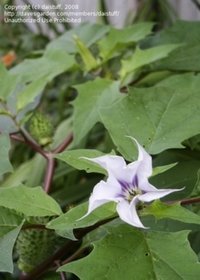
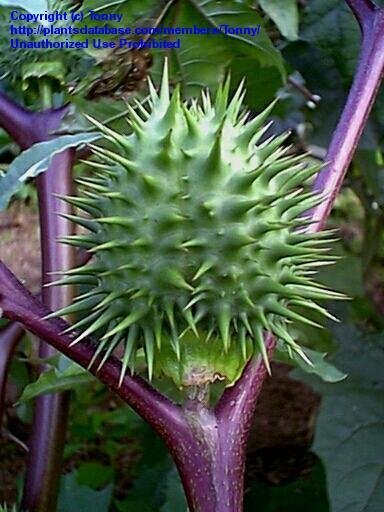 Datura var. tatulaMature green seedpod
Datura var. tatulaMature green seedpod
If you choose to harvest them green, make sure that the pods are indeed ripe. You'll be able to tell this by their large size, about the size of a golf ball, and their spines will be extremely hard and sharp. An immature seedpod's spines will be bendable and smaller. With gloved hands and sharp garden shears, cut at the base of the pod and let the pod fall directly into a shoebox or plastic bag so you can handle the spines as little as possible. The seedpods need to dry out for several weeks with as little moisture as possible. Any moisture can grow mold which could inhibit proper germination. You will know the seedpods are completely dried when they crack open and send out some seed. You can then dump out the rest of the seeds into a seed envelope.
If you choose to let the seeds to dry on the plant, which is probably less work, you need to wait until the seedpod has dried and cracked open. With gloved hands and sharp shears, cut the pod off at the base. The stem will be brittle, so be careful to not crack it so fast you pop all the seeds out and all over the ground. I found it easy to cut the stem and then balance the pod on my shears to transport them to a paper towel where I could dump out the seeds. If you want to cut the pod directly into a bag or box, this would work well, too.
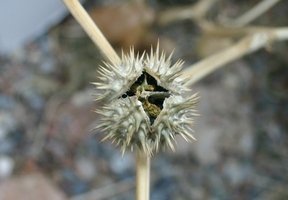
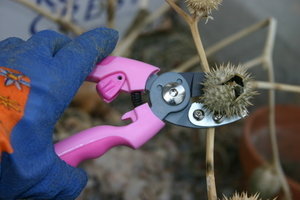
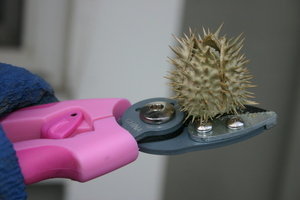 Dried and cracked open Datura tatula seedpod Cutting the at the base of the podHands-free transporting of the seedpod
Dried and cracked open Datura tatula seedpod Cutting the at the base of the podHands-free transporting of the seedpod
The seeds will pour out easily on a clean surface when turned over. Minimizing any contact with the seedpod will definitely save you some pain! Remember to wear gloves and use a sharp cutting utensil.
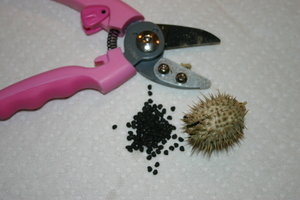 Seeds poured from dried seedpod
Seeds poured from dried seedpodBlanketflower (Gaillardia)
These seedheads might look innocuous, but squeeze one once and you'll not only never do it again, but you'll probably have a couple microscopic splinters in your finger to deal with. Just as with many other plants, you can harvest blanketflower seeds fresh or let them dry on the plant. Either way, the seeds need a completely dry environment for several weeks to dry correctly. If you choose to let the seeds dry on the plant, using gloved hands and scissors or shears, cut the seed heads off of the plant. You can hold the seedheads in your gloved hands, as they are not painful until you squeeze them.
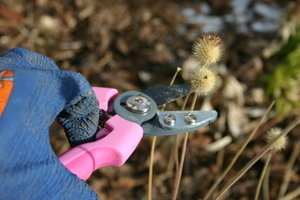 Blanketflower 'Razzledazzle'
Blanketflower 'Razzledazzle'

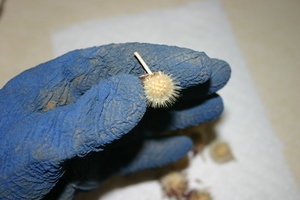
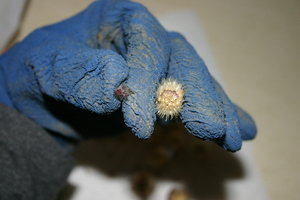 Cut the seedheads off the plant after they have dried Use gloved hands to pinch blanketflower seedheads!Pinch one side of the seedhead and pull outward
Cut the seedheads off the plant after they have dried Use gloved hands to pinch blanketflower seedheads!Pinch one side of the seedhead and pull outward
If you remove the seedheads before they are dried, lay them out on a paper plate and let them dry in a safe place until they are dry. At this point you can treat them the same as the seedheads that were dried naturally on the plant. Pinch the seedhead carefully between you finger and thumb in one hand and use your other hand to pinch and pull off one side of the seedhead. Once you pinch off an opening in the seedhead, the other seeds will be easier to remove. This will be like plucking the petals off a flower. Keep your gloves on until the seeds are safely in a seed envelope.
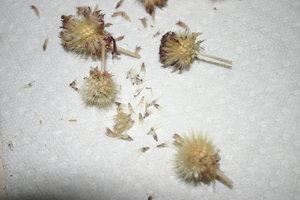 Dry seedheads, chaff, and removed seeds
Dry seedheads, chaff, and removed seeds
Castor Beans
As with datura, the castor bean seeds are very toxic. Please take care when handling this plant and when dealing with it indoors. Just as with the other examples in this article, castor bean seedpods can be dried on the plant or picked fresh once they are ripe. You will want the seeds to be completely dried out, which can take several weeks, in a safe spot away from pets and children.
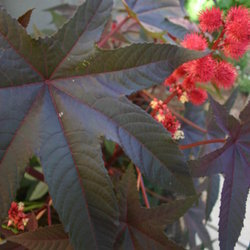 Castor Bean with striking seedpods
Castor Bean with striking seedpods
The dried seed pods are dark brown and quite firm. Squeezing them with your bare hands is not recommended for they have dull but stiff spines all over them. After several experiments, I have found that the best technique to crack these peculiar seedpods open is to use pliers. With gloved hands, place one seedpod in the grip of the pliers on its axis (the part it was connected to the plant on one of the mouth grips). Holding the seed over a box or plastic bag to catch the chaff and the seeds, squeeze the pliers to crack the seedpod open. The seedpod will break into 3 parts, each one contains its own seed. As you crush further, the three compartments will break open and release the seeds. Sort through the chaff and find the seeds, which look like a pinto bean with a dimple at one end.
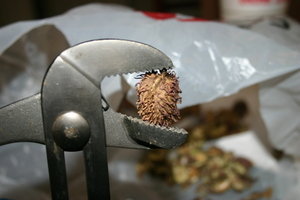
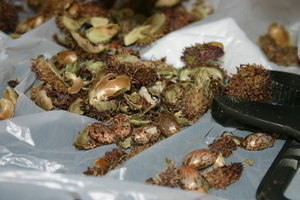
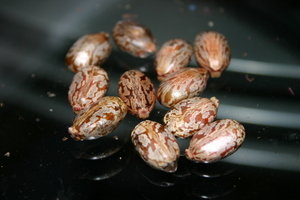 Cracking the seedpod at the axis with pliersChaff and seeds in plastic bagHarvested castor beans
Cracking the seedpod at the axis with pliersChaff and seeds in plastic bagHarvested castor beans
Take special care when dealing with these spiny, sometimes toxic seeds and seedpods. Some other seedpods to be wary of are teasel, sweetgum, lipstick plant, swamp milkweed, and prickly poppy.
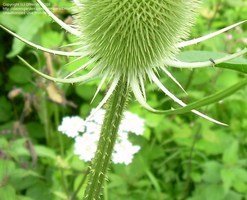
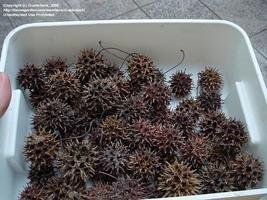
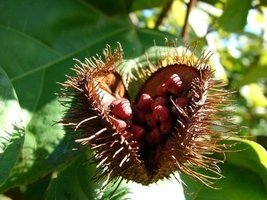 Teasel (Dipsacus fullonum)Sweetgum (Liquidambar styraciflua)Lipstick Plant (Bixa orellana)
Teasel (Dipsacus fullonum)Sweetgum (Liquidambar styraciflua)Lipstick Plant (Bixa orellana)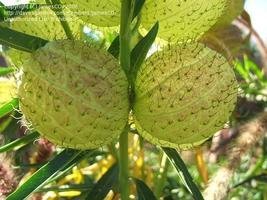
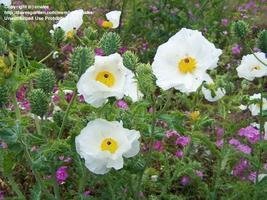 Swan Milkweed (Asclepias physocarpa) Prickly Poppy (Argemone pleiacantha)
Swan Milkweed (Asclepias physocarpa) Prickly Poppy (Argemone pleiacantha)
All images belong to the author with the exception of:
Datura tatula flower- Daistuff
Datura tatula green seedpod- Tonny_Surrow_Hansen
Teasel- DMersh
Sweetgum- Gustichock
Lipstick plant - Htop
Swan Milkweed- JamesCo
Prickly Poppy- Onalee
Copyright © www.100flowers.win Botanic Garden All Rights Reserved